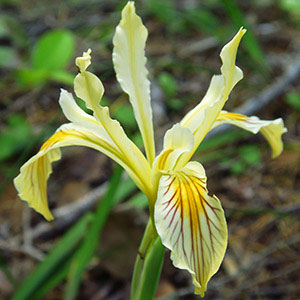Iris innominata
Iris bracteata
Del Norte County iris, Del Norte iris, golden iris
Siskiyou iris
freely branching, forming compact tufts, slender, 0.3–0.4 cm diam., covered with remains of old leaves;
roots fibrous.
sheathed with old leaf bases, slender, 0.6–0.9 cm diam.;
roots few, fibrous.
simple, solid, slender, 2–2.5 dm.
simple, solid, 1.5–3 dm.
basal evergreen, abundant, blade dark, shining green on one side, lighter green on the other, pink to deep purple basally, 3.5 dm × 0.2–0.4 cm, longer than flowering stem, margins not thickened;
cauline 2–4, sheathing stem for about 2/3 length, foliaceous, spreading, blade not inflated, 4–9 cm.
basal with abaxial surface of blades deep glossy green on one side of fan, light yellow-green on other side, pink or red-tinged basally, strongly ribbed, 4–6 dm × 0.8–1 cm, rigid, margins not thickened;
cauline 3–6, imbricated, closely sheathing stem ca. 2/3 length, spreading distally, bractlike, blade inflated, often shorter than basal leaves.
1(–2)-flowered;
spathes closely enclosing ovary and floral tube, broadly lanceolate to ovate, 3.3–6 cm × 5–7 mm, herbaceous, margins scarious.
simple, units 1–2-flowered;
spathes closed tightly around pedicel and ovary, lanceolate, 5.2–9 cm × 6–8 mm, subequal, herbaceous, margins scarious, apex acuminate.
perianth usually dark golden yellow, cream, pink, lavender, or purple, heavily veined purple or brown;
floral tube 1.5–3 cm;
sepals usually yellow with heavy veining, broadly oblanceolate, 4.5–6 × 1.7–3 cm, base gradually attenuate, margins often wavy;
petals same color as sepals with lighter veining, narrowly oblanceolate, 4–5.7 × 0.9–1.6 cm, base gradually attenuate;
ovary roundly triangular in cross section, 1.5–1.8 cm;
style 2–2.6 cm, crests overlapping, subquadrate to semiovate, 0.9–1.4 cm, margins irregularly toothed;
stigmas triangular, margins entire;
pedicel 0.4–1.3 cm at anthesis.
perianth cream to buff-yellow;
floral tube 0.8–0.9 cm;
sepals with deeper yellow signal, veined with purple or brown, obovate-lanceolate, 6.5 × 2.5 cm, base gradually attenuate into wide claw;
petals narrowly oblanceolate, 7–9 × 0.8–2 cm, base gradually attenuate;
ovary nearly circular in cross section, 1.5–2.5 cm, base gradually attenuate into pedicel, apex abruptly acuminate into floral tube;
style 2.2–3 cm, crests spreading, yellow, not veined, 1.2 × 0.9–1.7 cm, margins toothed;
stigmas triangular or tongue-shaped, margins entire;
pedicel 3–6.2 cm.
oblong-oval, circular in cross section, 2.5 × 1.2 cm.
nearly circular in cross section, tapering abruptly at each end, 2–2.5 × 1–1.5 cm.
in 2 rows per locule, dark brown, oval, sharply angled, 3 mm, wrinkled, pitted.
dark brown, irregular in shape, wrinkled.
= 40.
= 40.
Iris innominata
Iris bracteata
Iris innominata hybridizes with I. bracteata, I. chrysophylla, I. douglasiana, I. fernaldii, I. macrosiphon, I. munzii, I. purdyi, and I. tenax. It is known only from southwestern Oregon and Del Norte County in northwestern California.
(Discussion copyrighted by Flora of North America; reprinted with permission.)
Iris bracteata is limited to one county each in northern California and southern Oregon. It hybridizes with I. chrysophylla, I. douglasiana, I. innominata, I. munzii, I. purdyi, and I. tenax.
(Discussion copyrighted by Flora of North America; reprinted with permission.)


